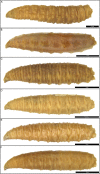Muscle attachment site patterns for species determination in West Palaearctic Wohlfahrtia (Diptera: Sarcophagidae) of medical and veterinary importance
- PMID: 31844098
- PMCID: PMC6915748
- DOI: 10.1038/s41598-019-55127-5
Muscle attachment site patterns for species determination in West Palaearctic Wohlfahrtia (Diptera: Sarcophagidae) of medical and veterinary importance
Abstract
The flesh fly genus Wohlfahrtia Brauer & Bergenstamm contains at least six species of medical and veterinary importance. Traditional methods of species identification in specimens of Wohlfahrtia, however, are restricted mostly to adult forms. Muscle attachment site (MAS) patterns allow for species determination in larval forms. MAS patterns in third instar larvae of six common West Palearctic species of Wohlfahrtia have been analyzed for this study. As in previously investigated Calliphoridae and Sarcophagidae, MAS patterns were found to be species specific. A genus pattern was established to be used as base for comparison in further species determination. For the first time a tool is provided for species identification of such broad range in larvae of Wohlfahrtia species. Wohlfahrtia patterns are composed of a significantly higher number of MAS than patterns found in Sarcophaga. Specifics of the six species analyzed are explained in detail. The larvae of the well-known species W. magnifica, an obligate traumatic myiasis agent, had to be excluded from the analysis as a great number of spines on the outside obscure muscle attachment sites on the inside of the cuticle.
Conflict of interest statement
The authors declare no competing interests.
Figures









Similar articles
-
Muscle attachment site (MAS) patterns for species determination in five species of Sarcophaga (Diptera: Sarcophagidae).Parasitol Res. 2016 Jan;115(1):241-7. doi: 10.1007/s00436-015-4740-4. Epub 2015 Sep 22. Parasitol Res. 2016. PMID: 26391172
-
Morphology of the first instar larva of obligatory traumatic myiasis agents (Diptera: Calliphoridae, Sarcophagidae).Parasitol Res. 2014 May;113(5):1629-40. doi: 10.1007/s00436-014-3808-x. Epub 2014 Feb 20. Parasitol Res. 2014. PMID: 24553979 Free PMC article.
-
Postembryonic development of Wohlfahrtia magnifica (Schiner, 1862) (Diptera: Sarcophagidae).J Parasitol. 1989 Aug;75(4):531-9. J Parasitol. 1989. PMID: 2760766
-
Fleshflies in the flesh: epidemiology, population genetics and control of outbreaks of traumatic myiasis in the Mediterranean Basin.Vet Parasitol. 2010 Nov 24;174(1-2):12-8. doi: 10.1016/j.vetpar.2010.08.010. Epub 2010 Aug 20. Vet Parasitol. 2010. PMID: 20850931 Review.
-
Sarcophaga (Liosarcophaga) dux (Diptera: Sarcophagidae): A flesh fly species of medical importance.Biol Res. 2014 Apr 1;47(1):14. doi: 10.1186/0717-6287-47-14. Biol Res. 2014. PMID: 25027360 Free PMC article. Review.
References
-
- Hall, M. J. R. & Farkas, R. Traumatic myiasis of humans and animals. Pages 751–768 in: Papp, L. & Darvas, B. (editors) Contributions to a Manual of Palaearctic Diptera (with Special Reference to Flies of Economic Importance), Vol. 1. General and Applied Dipterology. (Budapest, Hungary: Science Herald; 2000).
-
- Hall MJR, et al. Morphological and mitochondrial DNA characters for identification and phylogenetic analysis of the myiasis-causing flesh fly Wohlfahrtia magnifica and its relatives, with a description of Wohlfahrtia monegrosensis sp n. Wyatt & Hall. Medical and Veterinary Entomology. 2009;23:59–71. doi: 10.1111/j.1365-2915.2008.00779.x. - DOI - PubMed
Publication types
MeSH terms
LinkOut - more resources
Full Text Sources
Research Materials

